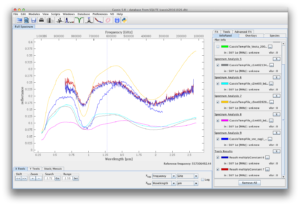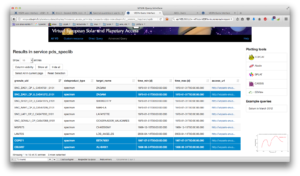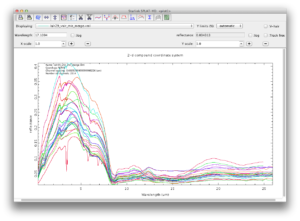The CRISM spectral library is a compilation of laboratory measurements of minerals, rocks, and meteorites in the visible, near-IR and mid-IR ranges. It was initially installed in support of the CRISM experiment on the Mars Reconnaissance Orbiter (MRO) mission (Murchie et al 2007, JGR 112:E05S03).
The CRISM spectral library is distributed as a dataset on the PDS Geosciences node
http://pds-geosciences.wustl.edu/mro/mro-m-crism-4-speclib-v1/mrocr_90xx/
and a web-based search interface was later implemented here: http://speclib.rsl.wustl.edu/.
This PDS service has been replaced by the larger PDS spectral library.
Virtual Observatory service
A Virtual Observatory (VO) data service has been setup to provide easier access to the CRISM spectral library content and to facilitate comparisons with observational data. In particular, this service is responsive to scripted queries on the web.
Only data formatting has been changed, plus description in some particular cases:
– All files (2260 entries) are provided as VOtable, which can be handled in VO tools (instead of PDS3 ascii files). Occasional duplicates are not removed.
– The flux scale is Reflectance factor, or REFF [= I/F / cos(i) ]. The uncertainty in wavelength is removed from these files when present.
– Thumbnails have been produced to provide a quick visual diagnostic in the VESPA portal and other interfaces.
The library is presented in a table with descriptive parameters for each spectrum, extracted from the PDS labels:
– Data description complies with the EPN-TAP protocol, with addition of extra parameters to accommodate most of the original label content.
– As a general rule, the original indexing and description of samples is not modified from the original PDS dataset. This leads to some inconsistencies and difficulties to locate spectra, even when querying the descriptive keywords (see below).
– Units are made consistent for each quantity (e.g., particle size always in µm).
– Some obvious formatting issues and inconsistencies are fixed both in the table and spectra.
This data service is responsive to the EPN-TAP data access protocol, and can be queried from the VESPA portal of Solar System data: http://vespa.obspm.fr/ and other TAP clients.
See the complete data service in VESPA (the schema name is crism_speclib).
A tutorial on spectral studies in the Planetary Science VO context is available here:
http://voparis-europlanet.obspm.fr/utilities/Tuto_Spectro_VESPA.pdf
In particular with the CASSIS tool:
http://voparis-europlanet.obspm.fr/utilities/Tuto_CASSIS_VESPA.pdf
In short: you first identify data of interest from a search interface, then send selected results in a visualization and analysis tool. The plotting tool of choice is CASSIS, but TOPCAT and SPLAT-VO are also convenient.

Fig.1: SNC meteorites from the PDS spectral library compared with spectra of 4 Vesta from the M4ast data service, in CASSIS
Looking for spectra
Searches can be performed from the VESPA portal or any TAP interface (TAPhandle, TOPCAT, etc). A specific EPN-TAP client is also installed in the CASSIS spectral tool.
Query results are tables, with a line describing each match. The column access_url provides a link to the VOtable version of the spectrum.
The main search parameters are:
sample_classification – complete original classification scheme (“specimen_class_name” keyword in PDS labels), provided as a list of values in lower cases separated by the # character. This keyword originally did not always contain the species name; it has been completed only in some cases.
granule_gid – contains the first 3 items of the original classification scheme, in lower cases. This parameter is intended to provide high level grouping
sample_desc – free format string from the original “specimen_desc” PDS keyword, in lower cases
granule_uid = obs_id – original “product_id” PDS keyword when available and unique, or derived from file name otherwise.
file_name – identical to the original PDS file name, except for the extension .xml
target_name – sample name as given by the spectrum producer, or closely derived (replaced by meteorite name when applicable), always in upper cases

Fig.2: the CRISM spectral library in the VESPA portal (result from a global query)
Standard query to find a given mineral species
The VESPA portal allows the user to issue requests from a graphical interface. It will query all available data services that use the EPN-TAP standard.
Actual TAP queries can also be issued from lower-level interfaces, using the ADQL language.
Such detailed queries can be performed in the ADQL Query mode of the VESPA portal, as well as from TOPCAT or TAPhandle. Beware that spectral range has to be queried in Hz (no conversion performed in this mode).
• The initial clause of the ADQL query is always
SELECT * from crism_speclib.epn_core
• Simple filters on the search parameters are attached to it, e.g.:
WHERE sample_classification LIKE ‘%jarosite%’
or
WHERE sample_classification LIKE ‘%olivine%’
However due to the original description of samples in the CRISM spectral library, not all spectra of interest will be retrieved this way.
Other possible ways to search include:
where sample_classification like ‘%nesosilicate%’
(which may include fayalite or forsterite)
where sample_desc like ‘%olivine%’
(although this parameter is mostly informative and not intended as a search key)
Queries for groups of materials can use the granule_gid parameter, which provides a rough grouping of materials on 3 items separated by underscores:
natural | synthetic
earth | moon | meteorite | from natural | mixture | multi-phase | single-phase
mineral | rock | unconsolidated | inorganic
Some special cases
– All meteorites spectra included in the database are from SNCs or are minerals extracted from meteorites
– Description of the SNC meteorite spectra are modified so that they are all identifiable with the request
granule_gid=’natural_meteorite_rock’
or (as all EPN-TAP services should include the meteoritic type in classification)
sample_classification like ‘%snc%’
which both provide 23 matches
In addition, the meteorite name is included in the target_name (reconstructed when it was not present)
target_name like ‘%NAKHLA%’
returns 3 spectra of Nakhla samples
Beware that the request
sample_desc like ‘%mars%’
mostly returns synthetic Martian analogues/simulants, rather than meteorites
– Other meteorites samples were all tagged as minerals (extracted from meteorites, mainly troilite). They can be found with the request
granule_gid=’natural_meteorite_mineral’
The main parameters are left unchanged (no mention of meteoritic type added in sample_classification, and target_name related to mineral) because the spectra are relative to minerals rather than specific meteorites. The information is available in sample_desc though.
– Description of the lunar samples are modified so that they are all identifiable with the request
granule_gid LIKE ‘%moon%’
or
sample_classification like ‘%moon%’
which provide 168 lunar samples identified in the PDS dataset
These include rocks, soils, and some extracted minerals, which are tagged respectively as natural_moon_rock, natural_moon_unconsolidated, and natural_moon_mineral
The lunar sample ID is included in the target_name in its original form, although the spelling is often inconsistent (misplaced underscores). It is not duplicated in the sample_classification parameter.
Ex: the ADQL query to select spectra in Fig. 3 is
SELECT * FROM crism_speclib.epn_core WHERE granule_gid LIKE ‘%moon%’ and sample_desc LIKE ‘%apollo 17%’ and spectral_range_min < 23000000000000
– Mixtures of minerals may be difficult to retrieve
A correct request according to the PDS dataset documentation is
sample_classification like ‘%multi-phase%’
which returns 246 results
However, other mixtures (tagged as earth#mineral) are found when requesting, e.g.:
sample_desc LIKE ‘%mixture%’
or
sample_desc LIKE ‘%px%’
or
granule_gid =’synthetic_from natural_inorganic’

Fig.3: 24 Apollo 17 samples encompassing the mid-IR range, displayed in SPLAT-VO
Extra information
• Bibliographic references are provided with the original PDS codes and are concatenated in a list of values separated by the # character. These codes refer to the original list found here:
http://pds-geosciences.wustl.edu/mro/mro-m-crism-4-speclib-v1/mrocr_90xx/catalog/ref.cat
• Elementary analyses and other information are available for some samples (from J. Bishop and T. Roush only, excerpts from the papers) in this directory:
http://pds-geosciences.wustl.edu/mro/mro-m-crism-4-speclib-v1/mrocr_90xx/extras/
• Spectral range conversion from Hz to µm goes like this:
– min_wvl = 2.99792458E14 / max_freq
– max_wvl = 2.99792458E14 / min_freq
• Bulk material is indicated as grain_size_min = grain_size_max = 10000.0 µm
(other encoding may be used occasionally, e.g. grain_size_max = 8888 in Bishop spectra is maintained)
grain_size_max = 0 means that no granulometry was originally provided.
Beware that grain size may be inaccurate due to incorrect conversion when deriving the PDS dataset from original sources – in which case they can’t be recovered from the available information.
• Viewing angles set to 0. are actually 0° – these parameters are set to NULL when unknown.
• Acquisition time is set to 1/1/1970 when unknown (not provided in the original archive).
Sending spectra to VO tools
Several VO tools open the VOtable versions of the spectra for plotting and analysis. They also accept the data sent through the IVOA SAMP protocol, in particular from the VESPA portal:
• CASSIS accepts files passed via SAMP as spectra only
• SPLAT-VO accepts files passed via SAMP either as spectra or tables
• TOPCAT accepts files passed via SAMP as tables only
Both CASSIS and SPLAT-VO check the spectral quantity of input spectra. A warning is issued in CASSIS when overplotting different quantities, but this does not prevent from plotting the spectra (manual scaling is required in this case).
Other major libraries of mineral spectra
Three other databases will benefit from an EPN-TAP interface and will be available for cross searches from the VESPA portal:
• The SSHADE service (Schmitt et al., EPSC, 2015) [published]: https://www.sshade.eu
including in particular the older GhoSST database (Schmitt et al. 2012, EPSC2012–960): Ghosst.osug.fr
• Berlin Reflectance Spectral Library (Henckel et al, EPSC 2017) [draft ready]
• The Berlin emissivity database (BED) (Maturilli et al., 2008, PSS 56, 420–425) [draft ready]
Other databases listed below are usual references, but are not interoperable in a VO context:
• USGS splib07a:
https://crustal.usgs.gov/speclab/QueryAll07a.php
~2500 spectra with convolved and over-sampled versions, software, etc (Kokaly et al. 2017, USGS TR 1035)
• JPL ASTER
https://speclib.jpl.nasa.gov/
Includes ASTER 2.0 (Baldridge et al 2009, Remote Sensing of Environment 113, 771–715)
+ Johns Hopkins University Spectral Library (spectra from Salisbury et al. 1991, Infrared (2.1-25 μm) spectra of minerals)
+ JPL Spectral Library (spectra from Grove et al 1992, TR JPL-Publ-92-2)
total of ~ 2500 spectra, including meteorites, lunar samples, water
• RELAB / Brown University
A very large, historical archive of mineral spectra (Pieters et al 1983, JGR 88, 9534–9544)
This dataset is included in: https://pds-speclib.rsl.wustl.edu/search.aspx
The catalogue is available here: http://www.planetary.brown.edu/relabdata/catalogues/Spectra_Catalogue.txt
Instructions for use: http://www.planetary.brown.edu/relabdata/ReadMeFirst.txt
• HOSERLab / Planetary Spectrophotometer Facility Winnipeg University
Large archive of minerals in form of xls files. Includes data from other facilities, in particular RELAB (Cloutis et al 2006, LPSC abs2121; Cloutis et al 2015, LPSC abs1187))
Access to data files: http://psf.uwinnipeg.ca/Sample_Database/
Documentation: http://psf.uwinnipeg.ca/Samples_Directory/
• ASU spectral library (emission)
http://speclib.asu.edu/
(Christensen et al 2000, JGR 105, 9735–9740)
Contact the helpdesk for comments: support.vespa@obspm.fr
_____________________
This data service is provided in the framework of the VESPA activity in Europlanet 2020 by Paris Astronomical Data Centre (PADC).
The Europlanet 2020 Research Infrastructure project has received funding from the European Union’s Horizon 2020 research and innovation programme under grant agreement No 654208. Additional funding was provided in France by the Action Spécifique Observatoire Virtuel and Programme National de Planétologie / INSU.

